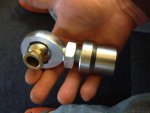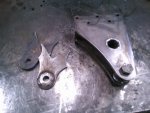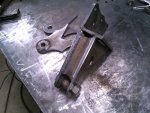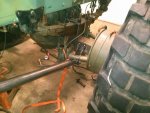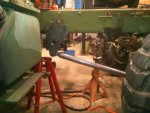Not sure I'm following you here. Can you please elaborate? Are you saying that the shackle will make the traction bar less effective when it comes to controlling axle-wrap? ...
No, not less effective. The discussion before is about bind and if the single traction bar will limit suspension travel. In theory.
Picture the design that Lt Dan just put up - this is exactly what I had in my mind from your description, yes? If you move the axle up and down, as it would for vertical travel through normal suspension compression; what happens to the end of the bar at the shackle - does it move up and down as well?
No - it's position is fixed because it is tied to the chassis. If the axle travels vertically 6", it wants the traction bar to move vertically 6" as well... but it won't. It will stay fixed to the chassis and nose the axle down.
Therefore, if the pinion angle is relatively unchanged through normal vertical travel within the leaf spring's range, then the traction bar is going to bind because it will force the pinion angle to change. As the rear is compressed, the bar will force the pinion angle downward, and as the axle droops, the bar will pull it upward. The point was just that this is the same problem as the 'crude' 4-link - it ain't perfect and ain't without some sort of bind. If the single traction bar is forcing the pinion angle opposite to axle travel, then it is effectively changing suspension performance - resisting compression and droop.
Again, if minimal disruption is a concern, then a longer bar will be better as it will not force as much of a change in pitch throughout the normal suspension cycle.
However, the single bar will have a much better chance of not limiting articulation.
However-however, this all still really doesn't matter much because these freakin' springs don't flex all that much to affect a whole lot.
In my opinion.
Or we could just add some slap-bars on and call it good!!!! I hear those things add like 50hp...




